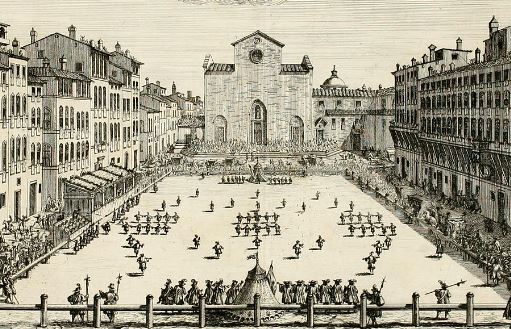Introduction
While rugby has carved its own distinct identity in the world of sports, its historical tapestry is interwoven with threads from various ancient games, one of which is the Italian Calcio Storico. Unlike any contemporary sport, Calcio Storico (or “historic football”) blends elements of soccer, wrestling, and rugby in a spectacle that dates back to the 16th century in Florence, Italy.
Origins and Evolution of Calcio Storico
Calcio Storico was first recorded in 1580 in the book Trattato del Giuoco della Palla by Giovanni de’ Bardi. This game has its roots even deeper in history, possibly emerging from the Roman military game Harpastum. The sport was initially played during special events such as the annual feast day of San Giovanni (St. John the Baptist) on June 24th. It gained immense popularity among Florentine nobles who played to showcase their physical prowess and celebrate aristocratic events.
Description of the Game
The game is played on a sand-covered field twice the size of a basketball court, surrounded by a 1.5-meter high fence. Two teams, each with 27 players, aim to get the ball into the opponent’s goal, known by the term ‘caccia’. The rules allow using both feet and hands while combining elements of wrestling to control opponents. Matches last for 50 minutes and are famously rough and tumble, with a look quite akin to the early forms of rugby, albeit much more violent.
Calcio Storico and Rugby: A Comparative Insight
Calcio Storico and rugby share several similarities that go beyond the use of a ball. Both sports emphasize physical strength, endurance, and team strategy. The use of hands to carry the ball and the objective of scoring by reaching an opponent’s territory echo in both games. However, unlike rugby, Calcio Storico has fewer rules regarding physical contact, leading to a much rougher form of play.
Influence on Rugby
Though the direct lineage of rugby can be traced to 19th-century England, the conceptual crossover from games like Calcio Storico is undeniable. The physicality and team-based strategies of Calcio Storico may have subtly influenced the early forms of rugby played in the British Isles. This connection points to a shared historical evolution of ball games that involve running, possession, and territory defense, underscoring a universal appeal and strategy that transcends culture and time.
Legacy and Modern Revival
Today, Calcio Storico is celebrated as a cultural heritage sport in Florence, with annual tournaments that draw both locals and tourists intrigued by its historic significance and raw intensity. The game is a living relic, offering a glimpse into the sporting life of Renaissance Italy and maintaining a sense of continuity with the past.
Conclusion
While Calcio Storico is not rugby, the echoes of its form and spirit resonate in the mauls, scrums, and tactical plays of modern rugby. Understanding the historical context and cultural significance of Calcio Storico enriches our appreciation of how ancient games have influenced and shaped the development of sports worldwide, including rugby. In studying these ancient sports, we gain insights not only into the pastimes of bygone eras but also into the evolution of human competition and camaraderie through sport.
This exploration into the rugged yet fascinating world of Calcio Storico not only broadens our perspective on the historical origins of sports but also celebrates the diversity and richness of human cultural heritage as expressed through athletic competition.
